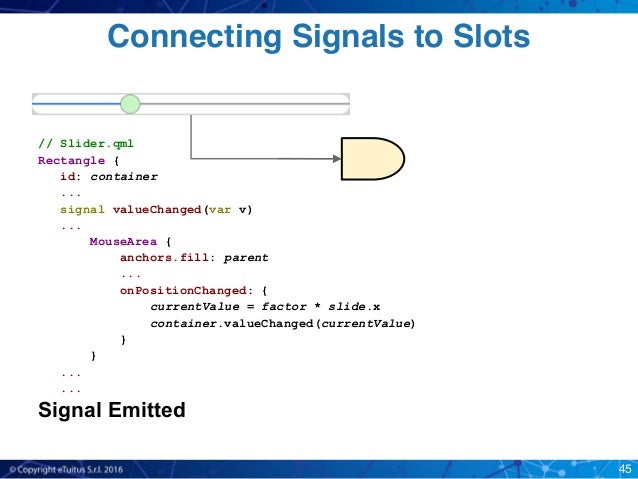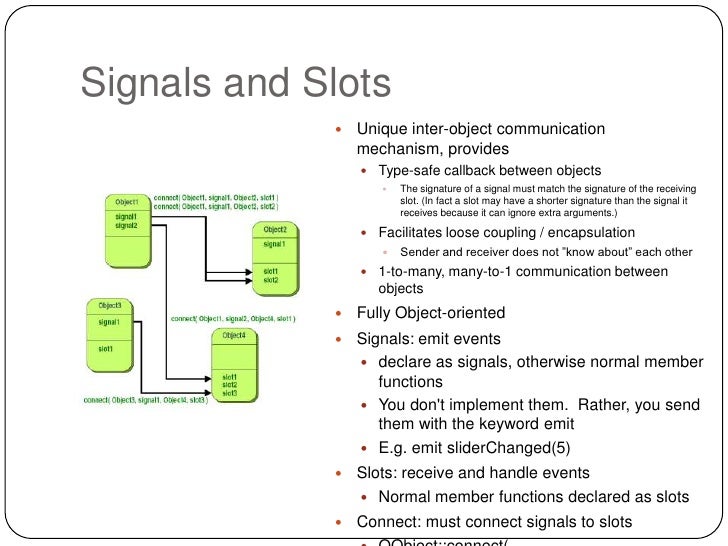Qt Connect Signal Parent Slot
One key and distinctive feature of Qt framework is the use of signals and slots to connect widgets and related actions. But as powerful the feature is, it may look compelling to a lot of developers not used to such a model, and it may take some time at the beginning to get used to understand how to use signals and slots properly. However, since version 4.4, we can relay on
Back in the old days, signals and slots connections were set up for compile time (or even run time) manually, where developers used the following sentence:
this is, we stated the sender object's name, the signal we want to connect, the receiver object's name and the slot to connect the signal to.
Now there's an automatic way to connect signals and slots by means of QMetaObject's ability to make connections between signals and suitably-named slots. And that's the key: if we use an appropriate naming convention, signals and slots will be properly connected without the need to write additional code for that to happen. So by declaring and implementing a slot with a name that follows the following convention:
suitably-named slots. And that's the key: if we use an appropriate naming convention, signals and slots will be properly connected without the need to write additional code for that to happen. So by declaring and implementing a slot with a name that follows the following convention:
uic (the User Interface Compiler of Qt) will automatically generate code in the dialog's
(the User Interface Compiler of Qt) will automatically generate code in the dialog's
So back to our example, the class implementing the slot must define it like this:
We then write the method's implementatio to carry on an action when the signal is emitted:
In brief, we have seen that by using automatic connection of signals and slots we can count on both a standard naming convention and at the same time an explicit interface for designers to embrace. If the proper source code implements such a given interface, interface designers can later check that everything is working fine without the need to code.One key and distinctive feature of Qt framework is the use of signals and slots to connect widgets and related actions. But as powerful the feature is, it may look compelling to a lot of developers not used to such a model, and it may take some time at the beginning to get used to understand how to use signals and slots properly. However, since version 4.4, we can relay on auto-connections to simplify using this feature.
Back in the old days, signals and slots connections were set up for compile time (or even run time) manually, where developers used the following sentence:
this is, we stated the sender object's name, the signal we want to connect, the receiver object's name and the slot to connect the signal to.
Now there's an automatic way to connect signals and slots by means of QMetaObject's ability to make connections between signals and suitably-named slots. And that's the key: if we use an appropriate naming convention, signals and slots will be properly connected without the need to write additional code for that to happen. So by declaring and implementing a slot with a name that follows the following convention:
uic (the User Interface Compiler of Qt) will automatically generate code in the dialog's setupUi() function to connect button's signal with dialog's slot.
So back to our example, the class implementing the slot must define it like this:
We then write the method's implementatio to carry on an action when the signal is emitted:
In brief, we have seen that by using automatic connection of signals and slots we can count on both a standard naming convention and at the same time an explicit interface for designers to embrace. If the proper source code implements such a given interface, interface designers can later check that everything is working fine without the need to code.
Qt/C - Tutorial 073. Signals and slots. Connecting Slots to Overloaded Signals in the Qt5 Syntax. Quite a frequent problem when working with signals with slots in Qt5, according to my observations on the forum, is the connection of slots in the syntax on the pointers to signals having an over.
auto-connectionsQt Connect Parent Signal To Child Slot
to simplify using this feature.Back in the old days, signals and slots connections were set up for compile time (or even run time) manually, where developers used the following sentence:
- Qt connects widgets by means of a nice designed scheme based on the idea that objectS may send signalS of different typeS to a single object instance: This is a screenshot of the example code running. The main application creates dialogs A and B and then connects the signal from A to the signal slot in B.
- Connect This method connects the signal to a slot. The signal can connect to a function, which takes its arguments and does something with them. For all practical purposes, you'll only need to pass the slot function to connect. Each signal can connect to an arbitrary amount of slot functions.
this is, we stated the sender object's name, the signal we want to connect, the receiver object's name and the slot to connect the signal to.
Now there's an automatic way to connect signals and slots by means of QMetaObject's ability to make connections between signals and
 suitably-named slots. And that's the key: if we use an appropriate naming convention, signals and slots will be properly connected without the need to write additional code for that to happen. So by declaring and implementing a slot with a name that follows the following convention:
suitably-named slots. And that's the key: if we use an appropriate naming convention, signals and slots will be properly connected without the need to write additional code for that to happen. So by declaring and implementing a slot with a name that follows the following convention:uic
 (the User Interface Compiler of Qt) will automatically generate code in the dialog's
(the User Interface Compiler of Qt) will automatically generate code in the dialog's Qt Connect Signal Parent Slot Machine
setupUi() function to connect button's signal with dialog's slot.So back to our example, the class implementing the slot must define it like this:
We then write the method's implementatio to carry on an action when the signal is emitted:
In brief, we have seen that by using automatic connection of signals and slots we can count on both a standard naming convention and at the same time an explicit interface for designers to embrace. If the proper source code implements such a given interface, interface designers can later check that everything is working fine without the need to code.One key and distinctive feature of Qt framework is the use of signals and slots to connect widgets and related actions. But as powerful the feature is, it may look compelling to a lot of developers not used to such a model, and it may take some time at the beginning to get used to understand how to use signals and slots properly. However, since version 4.4, we can relay on auto-connections to simplify using this feature.
Back in the old days, signals and slots connections were set up for compile time (or even run time) manually, where developers used the following sentence:

this is, we stated the sender object's name, the signal we want to connect, the receiver object's name and the slot to connect the signal to.
Now there's an automatic way to connect signals and slots by means of QMetaObject's ability to make connections between signals and suitably-named slots. And that's the key: if we use an appropriate naming convention, signals and slots will be properly connected without the need to write additional code for that to happen. So by declaring and implementing a slot with a name that follows the following convention:

uic (the User Interface Compiler of Qt) will automatically generate code in the dialog's setupUi() function to connect button's signal with dialog's slot.
So back to our example, the class implementing the slot must define it like this:
We then write the method's implementatio to carry on an action when the signal is emitted:
In brief, we have seen that by using automatic connection of signals and slots we can count on both a standard naming convention and at the same time an explicit interface for designers to embrace. If the proper source code implements such a given interface, interface designers can later check that everything is working fine without the need to code.